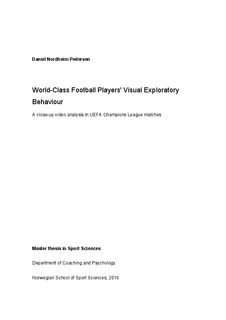| dc.description.abstract | The overall purpose of this study was to examine how football players explore the
environment and use the information to prospectively control subsequent actions with
the ball. A real world field study was conducted and Gibson’s (1966; 1979) ecological
approach to visual perception was used as conceptual framework. The relationship
between visual exploratory behaviour (VEB) and performance, VEB and various
situational characteristics, and the timing of the players’ VEB were examined. Eight
world-class midfield and forward players (M = 31.5 years, SD = 3.25) were filmed
“close-up” in five matches of the 2014/2015 UEFA Champions League group stages (M
= 56.13 minutes, SD = 40.36). These footages were edited together with the official
UEFA match broadcast, creating a split screen video for further examination of a total
of 269 situations and 851 visual exploratory behaviours (searches).
Results suggests a positive relationship between VEB prior to receiving the ball and
performance, where players are more successful in their forward actions and complete
more penetrating forward passes when exploring more compared to when exploring
less. Further, when players perform extensive VEB, they execute more actions in the
attacking direction, are more forward oriented when receiving, and are under less
defensive pressure compared to when exploring less. Finally, the players’ timing of
each search suggests that they initiate significantly more searches than expected in the
immediate moment the ball position and/or direction is determined. In conclusion, this
study suggests a positive relationship between VEB and performance in football, and
that VEB is used by players to get in a better position to execute their subsequent
actions. In addition, a VEB timing pattern is proposed. The development of visual
exploratory behaviour should be highly emphasised in football players’ daily training,
and some practical implications are presented. | nb_NO |
